|
|
|
|
|

SHITENNŌ = Four Heavenly Kings
SHITENNŌ = Lit. Four Heavenly Kings. Guardians of the Four Compass Directions,
Four Celestial Guardians, 4 Protectors of the Nation, 4 Lords of Dharma (Buddhist Law),
Four Keepers of the World (Gose Shitennō), Members of the Tenbu (Skt. = Deva)
ORIGIN: Pre-Buddhist Deities from India
|
|
|
|
Japanese
|
Chinese
|
Sanskrit
|
Korean
|
Tibetan
|
|
四天王
Shitennō
護世四天王
Gose Shitennō
|
四天王
Sì Tiān Wáng,
Ssu-T'ien Wang
|
चतुर्महाराज
Maharāja; Catur-mahā
-rājakāyikāḥ, Loka-pālatva,
Lokala, Lokapala,
Caturmaharaja
|
사천왕,
Sa Cheon Wang,
Sa Ch'ŏn Wang
|
Jjig-rtenskyong,
Jig rten skyong ba nyid
|
CLICK ANY IMAGE TO JUMP TO THAT PAGE
OVERVIEW: The Shitennō are Buddhist protectors of the four directions. They ward off evil, guard the nation, and protect the world from malicious spirits, hence the Japanese term Gose Shitennō 護世四天王, literally “four world-protecting deva kings.” Each represents a direction, season, color, virtue, and element (see below chart). They originated in India as deva generals protecting Lord Indra, but were later adopted into the Buddhist pantheon in China and Japan. Each dwells in and protects one of the four continents surrounding Mt. Shumisen 須弥山 (Skt. = Mt. Sumeru), the mythical home of the Historical Buddha and other Buddhist deities. In China and Japan, they are venerated as temple guardians and protectors of the nation. In China, statues of the four are often placed near temple entrances, but in Japan, effigies of the four are more commonly placed around the central deity on the main altar (the main dais is befittingly called the Shumidan 須弥壇). The four are commanded by Taishakuten (Skt. Indra), Lord of the Center. They are nearly always dressed in armor (yoroi 鎧), looking ferocious (funnusō 忿怒相), and carrying weapons or objects (jimotsu 持物) said to eliminate evil influences and suppress the enemies of Buddhism. They are also typically shown standing atop evil spirits (known as Jaki in Japan), symbolizing their power to repel and defeat evil. Sometimes they are depicted with a fiery halo behind them. Their attributes, however, are not rigidly prescribed and thus differ among Buddhist nations. Shitennō iconography is related to the Four Celestial Emblems (dragon, red bird, tiger, turtle) of China, who also guard the four cardinal directions. In Japanese statuary, the Shitennō are almost always portrayed in animated warrior poses rather than static postures of ease or meditation. Among the four, Tamonten (aka Bishamonten) is considered the most powerful, and over time, supplanted the other three in importance. Indeed, Bishamonten is the only member of the four worshipped independently in Japan, both as protector of Buddhist faith and as one of Japan’s Seven Lucky Gods -- one who brings wealth and prosperity. Bishamonten also supplanted Taishakuten (Lord of the Center) as an object of worship, but Taishakuten never enjoyed great status in Japan.
|

Jikokuten (East)
Chinese = Chíguó Tiān
Tang Dynasty, Ninth Century
H = 72 cm, W = 17 cm
Ink and colors on silk.
Palais du Louvre in Paris.
Paintings from the Hidden Library
Cave, Dunhuang, China
|
|
|
|
The four appear in numerous scriptures, including the the Goldern Light Sutra 金光明經 (Konkōmyō kyō). Translated by Dharmakṣema 曇無讖 in the early 5th century, by Baogui 寶貴 in the late 6th century, and by Chinese monk Yijing 義淨 (635-713), it teaches that rulers who worship this sutra will gain the protection of the four guardian kings 護四王 in safeguarding the nation and benefiting its people. The Golden Light Sutra, also known as the Konkōmyō saishō ō kyō 金光明最勝王経, was one of three texts of great influence in old Japan for protecting the nation -- the so-called "three scriptures for protecting the state" are the Golden Light Sutra, the Lotus Sutra 法華經 (Hokke kyō), and the Benevolent Kings Sutra 仁王經 (Nin ō gyō). In the popular Lotus Sutra -- translated into Chinese by Kumārajīva 鳩摩羅什 350 - 410 (Jp. = Kumarajū) -- they appear in the Dharani (26th chapter), with Jikokuten and Tamonten pledging on behalf of all four to protect those who embrace the sutra’s teachings.
The four Shitennō guardians were transmitted from India to China and elsewhere in Asia around the 6th century AD. One of the earliest representations of the four in China, dated to the late 6th century, is from the Dunhaung Caves (cave 428). Another early example is a gigantic stone statue of Tamonten located at the Longmen Grottoes (Fengxian Temple 奉先寺) in China, completed circa 672-675 AD. The four were introduced to Japan at least by the late 6th century, for Shōtoku Taishi (the first royal patron of Buddhism in Japan) commissioned the construction of Shitennōji Temple 四天王寺 in Osaka in 593 AD to venerate the four. According to the Nihongi 日本紀 (Chronicles of Japan; compiled around +720), Shōtoku had prayed to the four to help him defeat Mononobe no Moriya 物部守屋 (died 587) and other forces opposed to the introduction of Buddhism in Japan. Shōtoku achieved victory, and built Shitennōji Temple soon thereafter. Because of their early introduction to Japan, the four are widely disseminated throughout the Japanese islands -- nearly every major temple in every major region has its own set of the four. The four also appear often in the mandala paintings of Japan’s Esoteric Buddhist sects, but their functions and symbolism were largely supplanted from the 9th century onward by esoteric groupings such as the Five Tathagata (with Dainichi Nyorai in the center), Five Great Mantra Kings (with Fudō Myō-ō in the center), and the 12 Deva (guardians of the 12 directions). Outstanding extant sculptural sets of the four Shitennō can be found at:
- Hōryūji Temple 法隆寺 in Nara. Mid-7th Century. Wood. Oldest extant set of the four. National Treasures. See photo below.
- Taimadera Temple 当麻寺 in Nara. Hakuhō Period 白鳳時代 (645-710). The statue of Tamonten is, however, from the Kamakura period. The Hakuhō-era pieces are made using the hollow dry lacquer (dakkatsu kanshitsu 脱活乾漆) technique. Important Cultural Property (ICP).
- Tōji Temple 東寺 in Kyoto. Mid-8th Century. Life-size statues made of painted clay. See individual Shitennō pages for photos. National Treasures.
- Kōfukuji Temple 興福寺 in Nara. Heian Era 平安時代 (794-1185). Wood-core dry lacquer (Mokushin Kanshitsu 木心乾漆) and painted. National Treasures. See photo below.
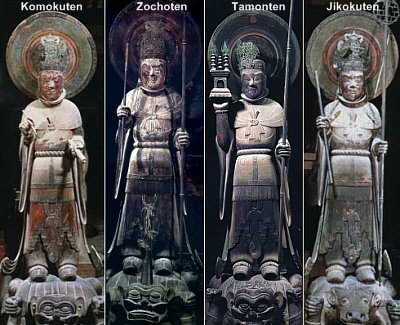
Shitennō (Four Heavenly Kings), Hōryūji Temple 法隆寺, Nara
Mid-7th Century. Oldest extant set of the four. National Treasures.
Kōmokuten 広目天, Zōchōten 増長天, Tamonten 多門天, Jikokuten 持国天
Painted Wood, Each Statue Approx. 133.5 cm in Height
Photos from Comprehensive Dictionary of Japan's National Treasures
国宝大事典 (西川 杏太郎. ISBN 4-06-187822-0.

Shitennō (Four Heavenly Kings), Kōfukuji Temple 興福寺, Nara
Heian Era, Wood-core dry lacquer (Mokushin Kanshitsu 木心乾漆) and painted. National Treasures 国宝.
Jikokuten 持国天 136.6cm; Zōchōten 増長天 136.6cm; Kōmokuten 広目天 139.7cm; Tamonten 多聞天 134.7cm
Source: Kōfukuji Temple Web Site
|
|
|
SHITENNŌ 四天王 = Four Heavenly Kings
Guardians of the Four Compass Directions
|
|
Jikokuten 持國天 (Japanese)
East, Spring, Water, Strength, Blue (White in India/China).
Rules over the Gandharvas & Piśācas.
Skt = Dhṛtarāṣṭra, Dhrtarasta, Dhritarashtra
C = Chíguó Tiān, Ch'ih-kuo T'ien
K = 지국천, Jiguk cheon, Chiguk ch'ŏn
Vietnam = Trì quốc thiên
|

Jikokuten
King of the East, Guardian of the Nation.
Keeper of the Kingdom.
|
|
Zōchōten 增長天 (Japanese)
South, Summer, Fire, Prosperity, Red (Blue in India/China).
Rules over the Kumbhāṇḍa 鳩槃荼.
Skt = Virūḍhaka, Virudhaka
C = Zēngcháng Tiān, Tseng-ch'ang T'ien
K = 증장천, Jeungjang Cheon, Chŭngjang Ch'ŏn
|

Zōchōten, Zouchoten, Zochoten
King of the South, Lord of Spiritual Growth.
One Who Expands Wisdom & Moderation.
|
|
Kōmokuten 廣目天 (Japanese)
Lord of Limitless Vision (has third “all-seeing” eye).
West, Fall, Metal, Awareness, White (Red in India/China).
Rules over the Nāga 龍 and Pūtana 富單那.
Skt = Virūpākṣa, Virupaksa, Virupaksha
C = Guǎngmùtiān, Kuang-mu-t'ien
K = 광목천, Gwangmokcheon, Kwangmokch'ŏn
Vietnam = Quảng mục thiên
|

Kōmokuten, Koumokuten, Komokuten
King of the West, Sees through evil.
Discerns / punishes badness.
Encourages aspirations for enlightenment.
|
|
Tamonten 多聞天 (Japanese)
North, Winter, Earth, Wealth, Black (Yellow in India/China).
Rules over the Yakṣas 夜叉 and Rākṣasas.
Skt = Vaiśravaṇa, Vaisravana, Vaishravana, Dhanada
C = Duōwén Tiān, Tuo-wen T'ien
K = 다문천, Damun Cheon, Tamun Ch'ŏn
Vietnam = Đa văn thiên
Manifestation of Kuvera (Hindu God of Wealth)
|

Tamonten (aka Bishamonten)
King of the North. All-Knowing.
Hears all, always listening.
One of Japan’s Seven Lucky Gods.
Well-versed in Buddha’s teachings.
|
|
Taishakuten 帝釈天 (Japanese)
Lord of the Center.
Commands the Shitennō.
Skt. = Indra
|

Taishakuten or Taishaku
Lord of the Heaven of 33 Gods
|
|
Shitennōten 四天王天 (Japanese)
Lit. = Four Heavens of Four Kings
Skt = Catur-maharāja-kāyikas
C = Sì tiānwáng tiān, Ssu t'ien-wang-t'ien
K = 사천왕천, Sa cheonwang cheon, Sa ch'ŏnwang ch'ŏn
V = Tứ thiên vương thiên
|
Says the Digital Dictionary of Buddhism (sign in with user name “guest): “The four are said to have appeared to 不空 Amogha in a temple in Xianfu (China), sometime between 742-6 AD, and in consequence he introduced their worship to China as guardians of the monasteries, where their images are seen in the hall at the entrance, which is sometimes called the 天王堂 (Hall of the Deva Kings). See 四天王經 or 倶舍論 T 1559.29.198a29; other sources Muller, Soothill, Hirakawa.
|
|
|
|
Historical Notes
Guardians of the Four Directions, Protectors of Buddhist Law, Protectors of Human Kind, Protectors of the Bosatsu and Nyorai. Most often found standing at the corners of alters. Ferocious looking, sometimes with fiery halo behind them, often stepping on demons called Jyaki. They protect the Buddhist realm for Taishakuten (Skt. Indra), serving as his generals to guard the territories inhabited by humans. Originally from Hindu mythology, and later incorporated into Buddhism. In the Lotus Sutra, they vow to protect those who believe in the Dharma (Buddhist teachings). In Japanese artwork, especially in the mandala form, the four typically appear in a set order, starting with Jikokuten (East), followed by Zōchōten (South), Kōmokuten (West), and Tamonten (North). All four are described in Sanskrit, Chinese and Japanese texts, but their attributes, colors, and names often vary.
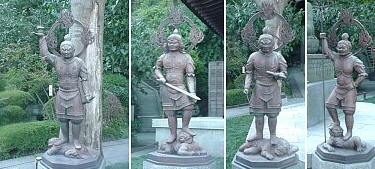
Four Heavenly Kings, the Shitennō. Click any image to jump to deity page.
At Hase Dera in Kamakura (life-size metal statues, modern)
From Left: Tamonten, Jikokuten, Kōmokuten, Zōchōten
Dressed in armor & trampling the Jaki (or Tentōki / Ryūtōki)
All four are depicted as warriors, and usually shown holding weapons, but there is no “hard” rule for the objects in their hands, and variations are common. Nevertheless, the objects they carry are always tools to eliminate evil influences and suppress the enemies of Buddhism. All four are Deva (Sanskrit), celestial beings who occupy the realm just above humans and just below the enlightened Bodhisattva. See Six Realms for details.
The Shitennō live halfway down the four sides of Mt. Shumisen 須弥山 (Skt. = Mt. Sumeru or Mt. Meru), the mythical home of Shakya Nyorai (Historical Buddha). According to Buddhist lore, Mt. Sumeru is located at the center of the universe, surrounded by eight mountain ranges, and in the ocean between the 7th and 8th there are four continents inhabited by humans. These four continents are protected by the Shitennō, with each leading an army of supernatural creatures to keep the fighting Ashura at bay. On the top of Mt. Sumeru is the heavenly palace of Shakya Nyorai, and the abode of the Trayastrimsha (33 Gods) ruled by Taishakuten, who commands the Shitennō.
Shitennō symbolism and artwork in Japan reflects not only its Hindu origins, but also its association with the four mythical Chinese creatures -- the dragon, red bird, tiger, and tortoise. These four creatures, known as the Celestial Emblems of the Chinese Emperor, are also guardians of the four compass directions, and appear prominently in artwork in China. Each has a corresponding season, color, element, and virtue -- so do each of the Shitennō. But in Japan, the four Chinese creatures are mostly supplanted by their Buddhist equivalents, the Shitennō. (Note: In Japan, there are statues of various followers of the Shitennō referred to as the Shitennō Kenzoku 四天王眷属.

Jaki or Jyaki 邪鬼 or Amano Jyaku 天邪鬼
Tentōki 天燈鬼 and Ryūtōki 龍燈鬼
Jaki is the name of the tiny creatures the four kings stand upon. Classified as members of the Yaksha in Japan; also referred to as the Amano Jyaku (Heaven Jyaku). In a tradition unique to Japan, the Jaki demons are sometimes represented by two creatures known as Tentōki (Tentoki) 天燈鬼 and Ryūtōki (Ryutoki) 龍燈鬼, which translate literally as Celestial-Lamp Demon and Dragon-Lamp Demon. Japanese legends say these two creatures were originally evil, but after getting trampled by the Shitennō, they repented, were saved, and now carry lanterns as offerings of light to the Buddha, or to light up the road in front of the Shaka Nyorai (Historical Buddha). The Jaki and Tentōki / Ryūtoki symbolize the power of the Shitennō to repel and defeat evil. Two wonderful sculptures of Tentōki and Ryutōki can be found at Kōfukuji Temple in Nara (see photos presented below).

Jyaki from 7th century, at Hōryū-ji Temple Temple 法隆寺, Nara
Scanned from temple brochure
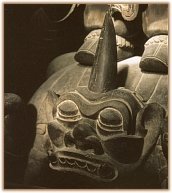
Jyaki under the feet of Zōchōten
Hōryū-ji Temple 法隆寺, Nara, 7th Century
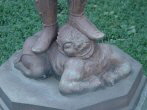 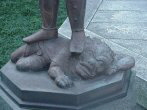 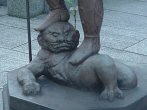
Jaki (Jyaki) at Hase Dera in Kamakura (click any image to enlarge)
See more photos of the Jaki demons in Below Photo Tour..
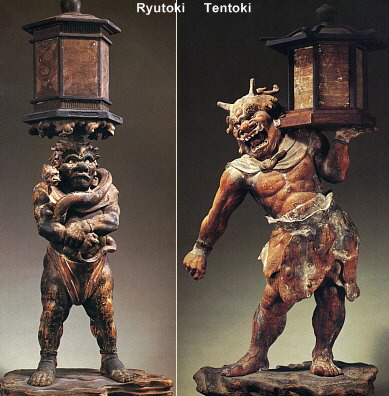
Ryūtōki Ryūzō 竜燈鬼立像, Two Jaki 邪鬼 demons carrying lanterns.
L: Ryutoki (Ryūtōki 龍燈鬼), H = 77.8 cm R: Tentoki (Tentōki 天燈鬼), H = 78.2 cm
Dated +1215, carved by Kōben. Wood with pigments. Kōfukuji Temple 興福寺 in Nara.
Inset crystal eyes (gyokugan 玉眼), Jointed-Block Technique (寄木造), Japanese Cypress.


PHOTOS FROM CHINA (2008, Longmen, Beijing)
Click any image for larger photo and details.


|
UNFINISHED BUSINESS
The Four Heavenly Kings at Tōdaiji Temple
The Great Buddha Hall (supposedly the world’s largest wooden building) at Tōdaiji Temple 東大寺 in Nara was rebuild in the early 18th century and is only 66% of its former size. Its rebuilding was completed in 1708 or 1709 but the repair and replacement of its damaged interior statues was still underway at the end of the century. The two large wooden statues of Kōmokuten and Tamonten, which are behind the Great Buddha statue, were carved during the Edo-period reconstruction of Tōdaiji Temple, but it wasn't until 1799 that work began on the Kōmokuten statue and then the Tamonten statue. The temple itself says the misogi kaji 御衣木加持 (esoteric incantation to purify and sanctify the wood before carving) for the Kōmokuten statue occurred in 1799, and Tamonten after that. A tour guide said the temple ran out of funds during the production of the four kings, which is why Tamonten is the only one painted. Kōmokuten is rather complete, sans polychroming. Zōchōten and Jikokuten were never finished -- but their carved heads are on display inside the hall. See photos below.
|
|
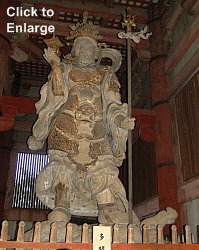
Tamonten
|
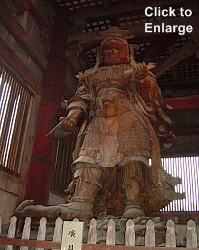
Kōmokuten
|
|

Heads of Zōchōten and Jikokuten. Their bodies were never finished.
|
|
SOURCES, LEARN MORE
- Buddhist-Artwork.com, our sister estore, offers statues of the Shitennō.
- Shijin (Four Celestial Emblems). The Shitennō are also associated with four legendary creatures of Chinese mythology (dragon, red bird, tiger, turtle).
- In the Japanese Mandala, the Shitennō are typically shown, from the top, starting with the eastern guardian. Thus, the typical order is Jikokuten (East), Zōchōten (South), Kōmokuten (West), and Tamonten (North).
- 28 Constellations, 28 Moon Lodges, 28 Moon Stations. Learn more about each of the four quarters (north, south, east, west) and the seven constellations in each group. All 28 represent points in the moon’s monthly path, and each was deified.
- Butsuzō-zu-i 仏像図彙, the “Collected Illustrations of Buddhist Images.” Published in 1690. One of Japan’s first major studies of Buddhist iconography. Hundreds of pages and drawings, with deities classified into approximately 80 (eighty) categories. Modern-day reprints of the expanded Meiji-era version are available at this online store (J-site).
- Mandara Zuten 曼荼羅図典 (Japanese Edition). The Mandala Dictionary. 422 pages. First published in 1993. Publisher Daihorinkaku 大法輪閣. Language Japanese. ISBN-10: 480461102-9. Available at Amazon.
- JAANUS. Japanese Architecture & Art Net Users System. Compiled by the late Dr. Mary Neighbour Parent; covers both Buddhist and Shintō deities in great detail and contains over 8,000 entries.
- A Dictionary of Chinese Buddhist Terms. With Sanskrit & English Equivalents. Plus Sanskrit-Pali Index. By William Edward Soothill & Lewis Hodous. Hardcover, 530 pages. Published by Munshirm Manoharlal. Reprinted March 31, 2005. ISBN 8121511453.
- Digital Dictionary of Chinese Buddhism (C. Muller; login "guest")
- Buddhism: Flammarion Iconographic Guides, by Louis Frederic, Printed in France, ISBN 2-08013-558-9, First published 1995.
- Handbook on Viewing Buddhist Statues. 仏像の見方ハンドブック. Published 1998. Author Ishii Ayako. Japanese-language only. 192 pages; 80+ color photos. A wonderful pocket-book.
- Art and Archaeology, Shitennō Page. Site author Michael D. Gunther. Educational site dedicated to art history, including the shrines and temples of Japan, and Japanese Buddhist sculpture.
- Four Heavenly Kings, Nichiren Tradition (outside link). “They appear in the ceremony of the Lotus Sutra with their 10,000 retainer gods in the Dharani (26th chapter). Therein, Jikokuten and Tamonten (aka Bishamonten) pledge on behalf of all four to protect those who embrace the Lotus Sutra.” Also see 4 Heavenly Kings, Great Mandala Study Group (outside link)
- Four Heavenly Kings (J-site, outside link), plus Sanskrit characters used herein.
- See Bibliography for our complete list of resources on Japanese Buddhism

|
|